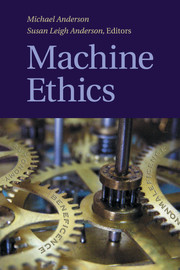Book contents
- Frontmatter
- Contents
- General Introduction
- PART I THE NATURE OF MACHINE ETHICS
- PART II THE IMPORTANCE OF MACHINE ETHICS
- PART III ISSUES CONCERNING MACHINE ETHICS
- PART IV APPROACHES TO MACHINE ETHICS
- Introduction
- 14 Towards the Ethical Robot
- 15 Asimov's Laws of Robotics
- 16 The Unacceptability of Asimov's Three Laws of Robotics as a Basis for Machine Ethics
- 17 Computational Models of Ethical Reasoning
- 18 Computational Neural Modeling and the Philosophy of Ethics
- 19 Architectures and Ethics for Robots
- 20 Piagetian Roboethics via Category Theory
- 21 Ethical Protocols Design
- 22 Modeling Morality with Prospective Logic
- 23 An Integrated Reasoning Approach to Moral Decision Making
- 24 Prototyping N-Reasons
- 25 There Is No “I” in “Robot”
- 26 Prospects for a Kantian Machine
- 27 A Prima Facie Duty Approach to Machine Ethics
- PART V VISIONS FOR MACHINE ETHICS
- References
19 - Architectures and Ethics for Robots
Constraint Satisfaction as a Unitary Design Framework
from PART IV - APPROACHES TO MACHINE ETHICS
Published online by Cambridge University Press: 01 June 2011
- Frontmatter
- Contents
- General Introduction
- PART I THE NATURE OF MACHINE ETHICS
- PART II THE IMPORTANCE OF MACHINE ETHICS
- PART III ISSUES CONCERNING MACHINE ETHICS
- PART IV APPROACHES TO MACHINE ETHICS
- Introduction
- 14 Towards the Ethical Robot
- 15 Asimov's Laws of Robotics
- 16 The Unacceptability of Asimov's Three Laws of Robotics as a Basis for Machine Ethics
- 17 Computational Models of Ethical Reasoning
- 18 Computational Neural Modeling and the Philosophy of Ethics
- 19 Architectures and Ethics for Robots
- 20 Piagetian Roboethics via Category Theory
- 21 Ethical Protocols Design
- 22 Modeling Morality with Prospective Logic
- 23 An Integrated Reasoning Approach to Moral Decision Making
- 24 Prototyping N-Reasons
- 25 There Is No “I” in “Robot”
- 26 Prospects for a Kantian Machine
- 27 A Prima Facie Duty Approach to Machine Ethics
- PART V VISIONS FOR MACHINE ETHICS
- References
Summary
Introduction
Intelligent robots must be both proactive and responsive. that requirement is the main challenge facing designers and developers of robot architectures. A robot in an active environment changes that environment in order to meet its goals and it, in turn, is changed by the environment. In this chapter we propose that these concerns can best be addressed by using constraint satisfaction as the design framework. This will allow us to put a firmer technical foundation under various proposals for codes of robot ethics.
Constraint Satisfaction Problems
We will start with what we might call Good Old-Fashioned Constraint Satisfaction (GOFCS). Constraint satisfaction itself has now evolved far beyond GOFCS. However, we initially focus on GOFCS as exemplified in the constraint satisfaction problem (CSP) paradigm. The whole concept of constraint satisfaction is a powerful idea. It arose in several applied fields roughly simultaneously; several researchers, in the early 1970s, abstracted the underlying theoretical model. Simply, many significant sets of problems of interest in artificial intelligence can each be characterized as a CSP. A CSP has a set of variables; each variable has a domain of possible values, and there are various constraints on some subsets of those variables, specifying which combinations of values for the variables involved are allowed (Mackworth 1977). The constraints may be between two variables or among more than two variables. A familiar CSP example is the Sudoku puzzle.
Information
- Type
- Chapter
- Information
- Machine Ethics , pp. 335 - 360Publisher: Cambridge University PressPrint publication year: 2011
References
Accessibility standard: Unknown
Why this information is here
This section outlines the accessibility features of this content - including support for screen readers, full keyboard navigation and high-contrast display options. This may not be relevant for you.Accessibility Information
- 6
- Cited by
